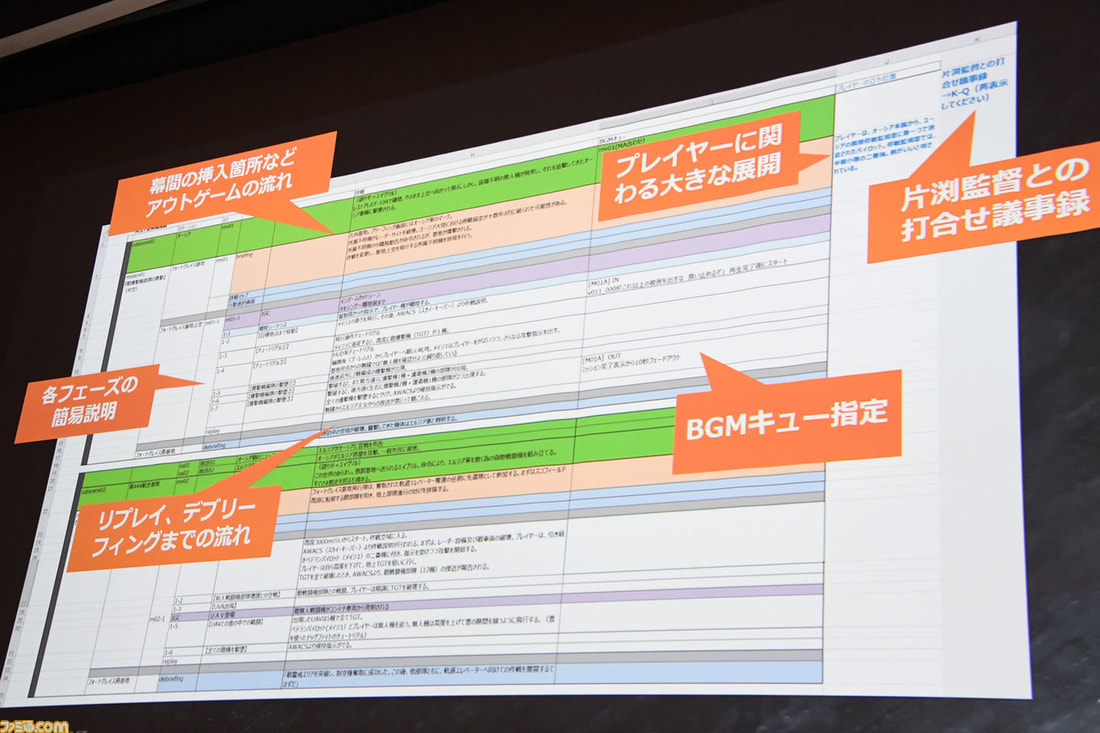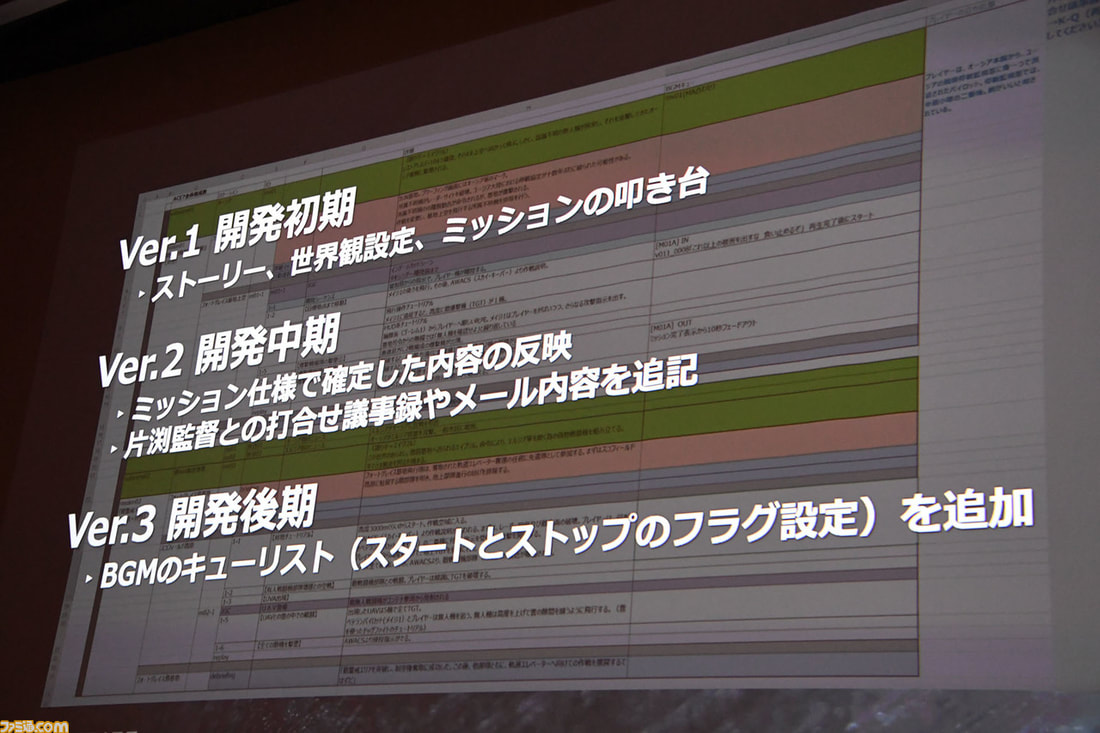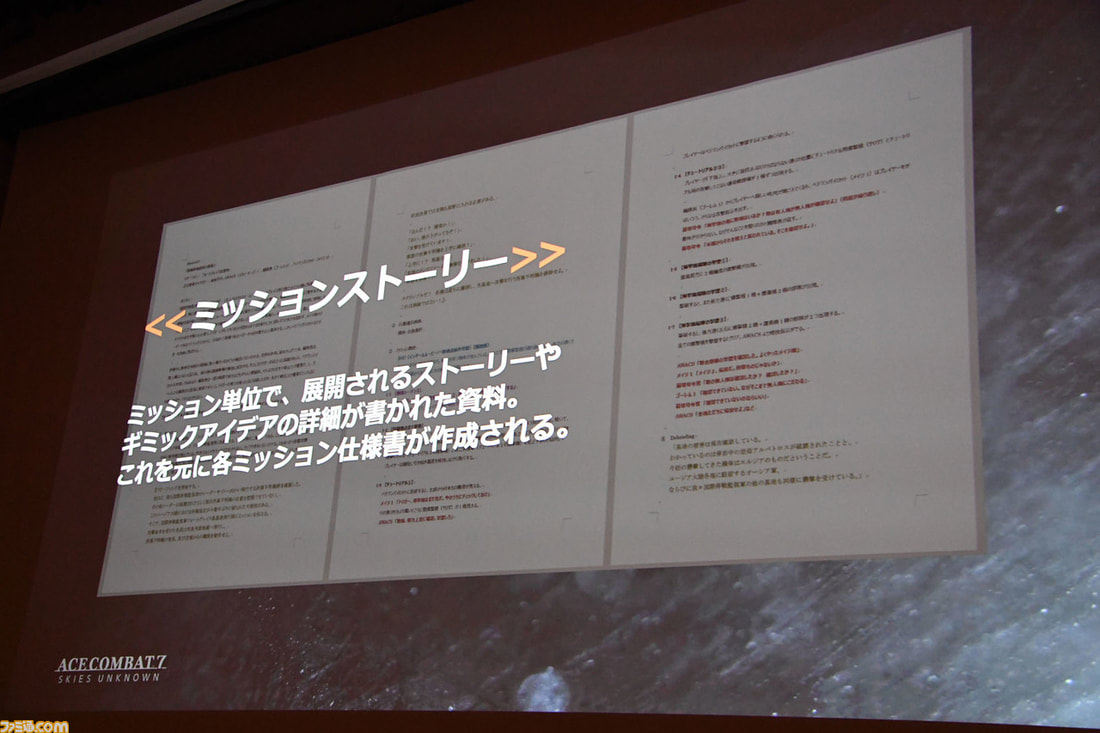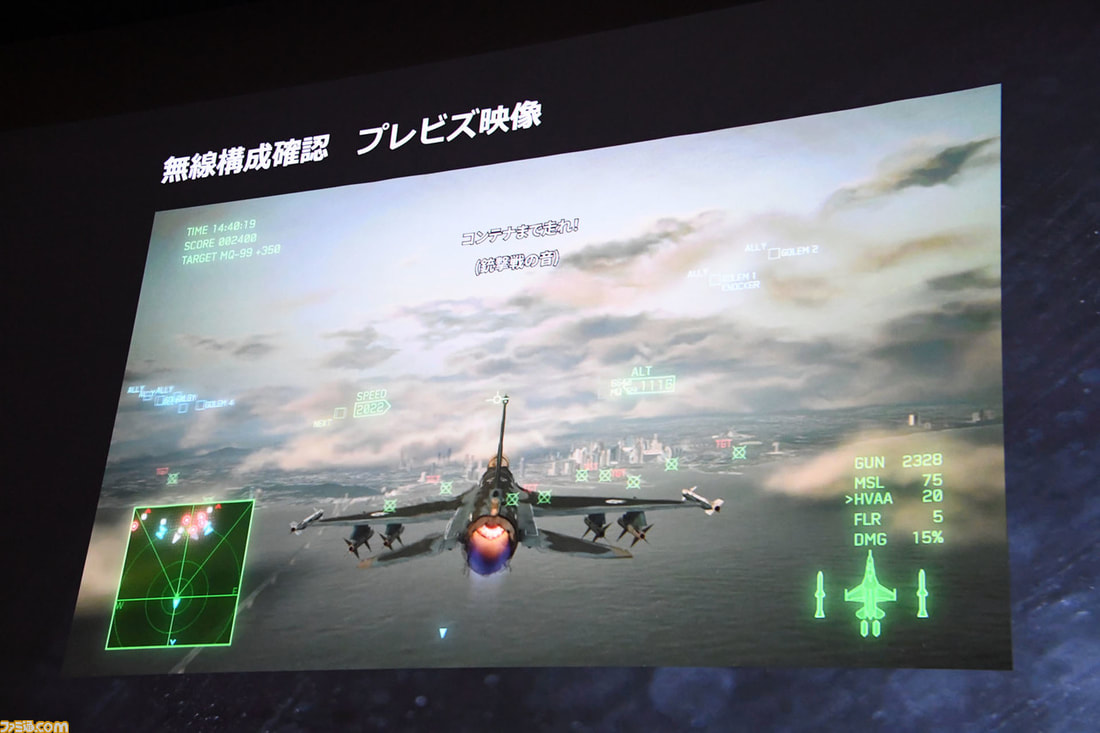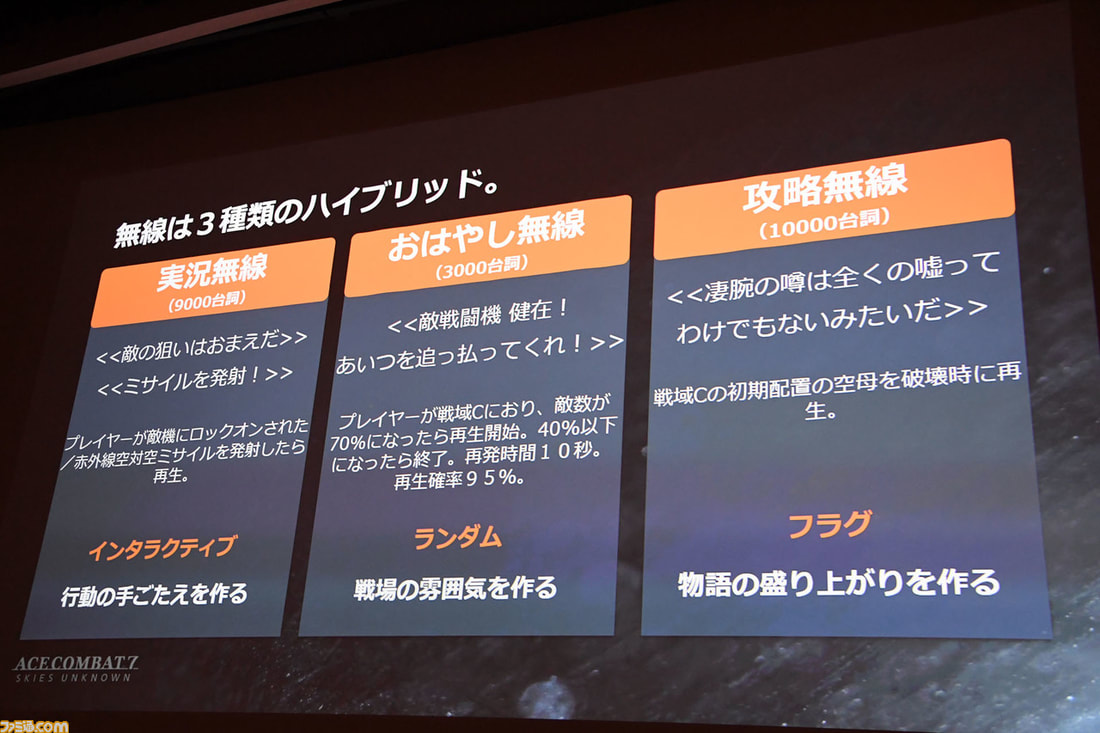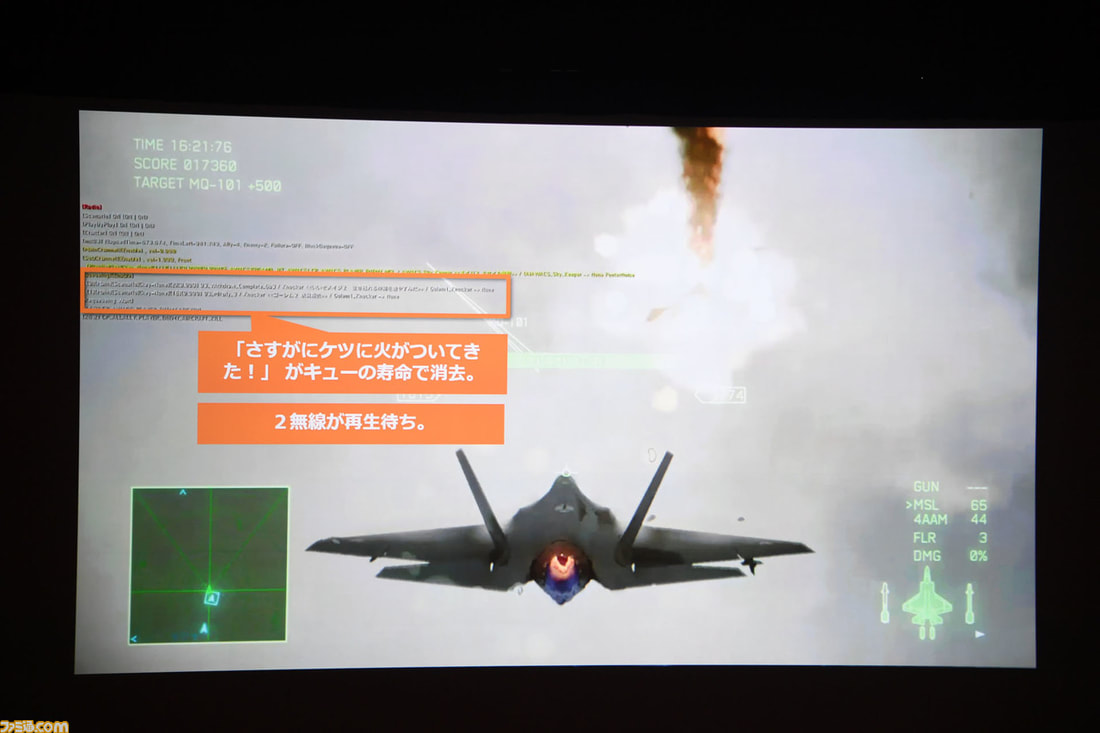PA talks about tools used in Ace Combat 7's development – a translation of Famitsu's summary6/9/2019 Why yes buddy, as a matter of fact we are still alive. What a year it's been. A lot has happened since last time we've posted here. Some good. Some bad. Mostly bad. But hey, Ace Combat 7 came out! That's good, probably! The rest of the World News which the official site seemed to imply never materialized, so I'm afraid we haven't updated much lately. We're still watching just in case, but as it turns out, the next big thing came not from the official site but Famitsu in the form of an article summarizing a presentation Kosuke Itomi and Masahide Kitou gave at CEDC. If you'll recall, the official sites for a lot of classic Ace Combat games had production journals where the staff talked about how things were going and a bit about the production process itself. You'll also notice that we haven't translated these because, not being lore-related, they're not strictly within the scope of this site. I'd like to translate some of these eventually, but that's going to be a fuck-off huge amount of work for what is ultimately a side project. This presentation seems to cover some of the things that an Ace Combat 7 production journal might've touched on though, so I thought I'd translate the whole thing in full. The secret of Ace Combat 7’s radio chatter!? Many innovations were made to merge gameplay and story! CEDC 2019 – the biggest conference in Japan aimed at computer entertainment announcements – was held between September 4th and 9th 2019 at the Pacific Convention Plaza in Yokohama. Here is our synopsis of the session “Sharing the kind of story we'd like to tell ~ the narrative production techniques of Ace Combat 7” which took place at the conference. The role of a narrative director in improving the gameplay experience holistically, including story Ace Combat 7: Skies Unknown: a game by Bandai Namco Entertainment which connects rich worldbuilding with a story told through serious dialog exchanges. At this session, we were given an introduction to their storytelling techniques and to the innovations which they’d developed for themselves. Appearing on stage during the first half was Kosuke Itomi, who served at Bandai Namco Studio as narrative director on Ace Combat 7, and who has been involved with the Ace Combat series since 3. The discussion eventually came around to the topic of what Itomi’s role as narrative director was. A narrative director is in charge of planning out every element of the game’s direction and story. By “narrative” they don’t just mean he’s in charge of the “story,” but also all the related elements involved in storytelling like direction and music. To that end, his job ranges widely from setting down the general blueprint for production, to managing the story, conceptualizing the movies and music, and supervising the audio recording. He stands alongside planning and sound engineering staff related to these things, and improves the overall quality of the game experience. You might say he is the one who keeps everything related to the narrative on track. This scope is quite wide, and the tools which Itomi used in this key position include scene planning tables, “mission story,” and pre-visualization. The first of those – the scene planning tables – summarize the flow of the campaign mode from start to finish. It creates a large outline of the flow of the entire story. This is where the story’s flow and worldbuilding – and the basis for all the missions which stem from the story – are collated during initial stages of development. The specifications for each mission are decided upon during the mid stages of development and reflected here, as well as additional notes in the form of emails and minutes from meetings with anime screenwriter and director Sunao Katabuchi, who is in charge of the scripts. Further, in the final stages of development, a cue list (flags for starting and stopping) is added for the BGM – an inseparable part of the play experience. This is how the play experience is constructed. Scene Construction Table
Top left to right:
Ver.1 Initial Phase
The second tool, the “mission story,” is as the name implies, a collection of all the resources for any given mission in one place, with details about the story and gimmicks which unfold during the mission itself. By adding in the the in-mission script and appending time codes, the “mission story” is managed. As you might expect, many conversations take place between staff members while building the missions and story, and when there are scenes where the level design and story conflict and become out of balance, they work to pare down the dialog. This, among other things, makes it very easy for aberrations to develop which run counter to the original vision. To prevent this from happening, Itomi thought to create a backbone for the story. He took down Katabuchi’s answers to questions like “Why did you have this part like this? Why is this dialog important?” in emails and meetings for as long as her could, so that after the fact he could remember why things are the way they are. Mission Story A resource where the story and gimmick ideas for each mission are written down. Each mission specification sheet is created based on this. Top left to right:
A backbone for the story during development is vital In the scene construction table, notes from meetings with Katabuchi and email content are noted as they relate to the scene. “Why did you have this part like this? Why is this dialog important?” As time passes, recollection will fade. We took as many notes as we could, and by mentioning them alongside the scene, we could see plainly what was originally meant. The third item, pre-visualization, is used so that staff may properly share between themselves things which are difficult to explain in words like radio communication timing and BGM cue timing. In other words, it’s a specification document in video form. Itomi presents Ace Combat’s storytelling like a radio drama. It is a drama formed out of radio conversations, breathing noises, pauses, and environmental sound effects. For things like this, it’s faster to explain the key points by making a video instead of using words. Pre-visualization Previs is a video used to validate concepts during the production of CG video and movies. A simple video is made to determine dialog and music selection, as well as playback timing. By sharing a complete image, trail and error in the actual version is kept to a minimum. Radio validation previs movie Ace Combat’s storytelling is a radio drama For instance… If a pause is short, it expresses breathlessness and impatience, and if it’s long, it indicates contemplation and holding back emotion. It’s a simple thing, but the chaining together of pauses creates part of the drama. Environmental sound effects going on behind the transmission source are also an important element of creating drama. Here, Itomi gave us an introduction to the concept of dividing music up and determining loop points so that the high points in the music flow naturally with the excitement of the gameplay. [1] The amount of time different players will spend playing any given part of Ace Combat 7 will vary, so they wanted to match the music with how the mission is progressing so as to make the play experience more exciting. How it works is that the track’s B and C melodies are divided into looping parts called “landings” and played back. As the player advances through the mission, once a break point is reached, it proceeds to the D melody. This is to say, climaxes which fit the gameplay are made to loop in a way which feels natural.
Finally, Itomi talked about how the development information’s “freshness” was important. If feedback to address problems in development comes too late, those problems are dismissed, and they become irreversible. In severe cases, the problem itself can be lost and left as-is. He told us fresh data is valued for that reason, and getting feedback as quickly as possible is important. Fresh information is vital During development, there’s always one thing after another that needs looking after. If feedback is late, the scope of a problem becomes frightening. With previs we can quickly arrive at a finished image, and getting retakes is quick and easy, so while information remains fresh, we can validate an image. Ace Combat 7’s radio chatter is mixed into three types and fit to match the gameplay! Masahide Kitou took the stage in the last half. He was in charge of the writing and implementation of the radio dialog. Kitou started by saying that the interactive gameplay, and the text, sounds, and dialog of the story mix like oil and water. As mentioned above, it’s hard to reconcile the fact that different playthroughs will vary in play time – and what state the game will be in at any given moment – with the fixed nature of text and voice. This is called “ludonarrative dissonance:” the situation when the gameplay and the story are out of harmony. Interactive gameplay mix with the text and voices of the story like oil and water Ludonarrative dissonance: the state of dissonance between game and story Ace Combat 7 has three types of radio dialog in order to adapt to the troublesome nature of interactive gameplay. They are “situational transmissions,” “greek chorus transmissions,” and “strategic transmissions.” Of these, situational transmissions play in reaction to player actions. They’re feedback to gameplay, and increase the sense that the game is responsive to the player. Greek chorus transmissions are, to name an example, things that might play when the player is in a particular map and the enemy forces fall below 70%. They’re transmissions which play when certain conditions are met. They create a sense of atmosphere in the battle space. Strategic transmissions are the kind of thing that might play when the player destroys a particular target. They’re transmissions that tell the player about plot points when they get to them, and help develop the story. All radio transmissions are divided in three types.
With these three types of radio transmission, the play experience and story progression can be complemented by natural radio chatter even during fluid mid-mission gameplay. All these things are controlled by the RadioTable and the queue. The RadioTable is where radio chatter which might play during a mission is collated. For this lecture, it was put in an Excel-like table to make it easy to grasp. Transmissions which play in response to gameplay are entered into a queue and wait in order to be played. However, each transmission has various parameters for playback appended on the RadioTable. First of all is Priority, which moves items up the queue in relation to their importance. Next is QueueLimitLife. Voice lines in the queue waiting to be played whose queue lifespan has expired are removed. For instance, if you shoot down an enemy plane, but a voice line with higher priority is playing, if too much time elapses since you’ve shot it down by the time the line ends, it wouldn’t be natural for there to be a “bandit down!” line anymore. Items are given a lifespan so that this never happens. Additionally, there’s a RequeueingWaitTime. This is a parameter by which once something has played once, it won’t enter the queue again for a specified interval. It’s unnatural if the same transmission plays non-stop, and this guards against that. The odd man out is the StartDelay parameter. Voices wait a specified amount of time before playing. By putting these delays in the radio exchanges, one may read contemplative pauses and restrained emotions into the conversation. For instance, you can see a glimpse of a squadron member’s chagrin by the delay of her reply after being bested by her captain. This is the kind of affect you can achieve with this parameter. With the RadioTable, we have a control for voice playback without going into the level editor ①Priority Sorts items in the queue according to priority. Generally it’s “Strategic > Greek Chorus > Situational” ②QueueLimitLife Transmissions are removed from the queue at a specified time after having been triggered to play. Given to transmissions which would be weird if delayed too long. ③RequeueingWaitTime After having played once, an item won’t enter the play queue until a specified amount of time has elapsed. Interval. Given to items which would be disconcerting if they played continuously. ⑤StartDelay Wait a certain amount of time before voice playback. If there isn’t this delay, the characters would seem less human (and more like a game) “Oh yeah, his ass is burning alright!” Has been removed from the queue due to hitting its lifespan. Two transmissions are awaiting playback. The three types of the Ace Combat series’ indispensable radio dialog are managed in their various aspects by assigning different parameters, created so that the fluid gameplay mixes naturally. Kitou refers to managing the transmissions combined all together and mixed within the queue as “stirring.” Once combined and emulsified, the oil and water of gameplay and story will mix. If mixed adeptly using these concepts, game and narrative will play in concert. On that note, the presentation concluded.
6 Comments
17/6/2024 08:51:09 am
Your appreciation means a lot! It's like putting together a puzzle—finding the perfect word is like finding that missing piece that completes the picture of your writing. Keep practicing, and you'll definitely see progress!
Reply
Leave a Reply. |




